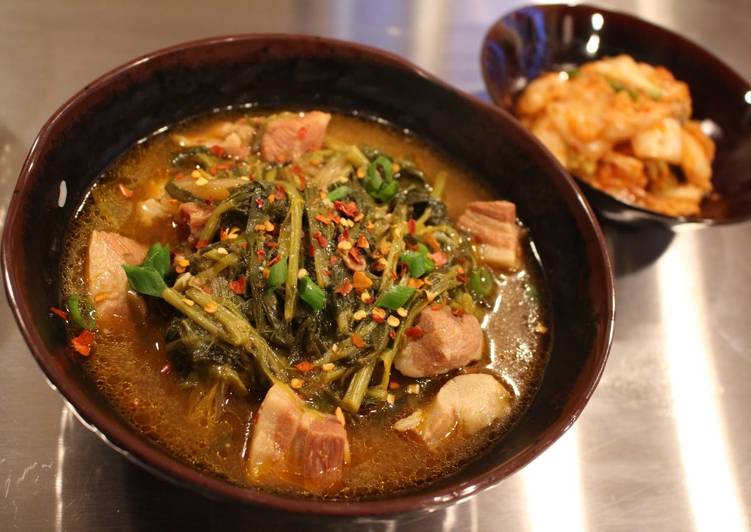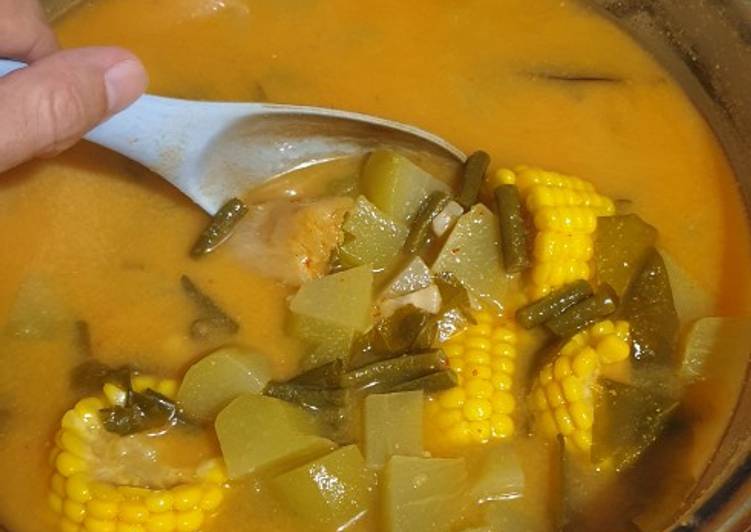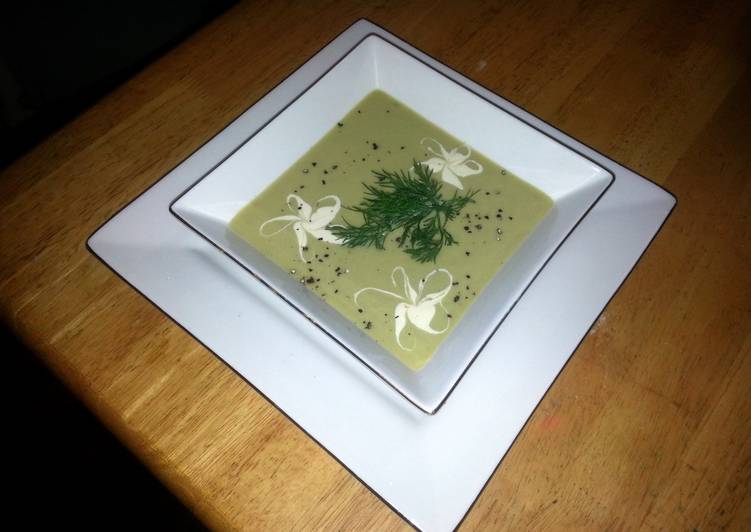
Hello everybody, hope you are having an incredible day today. Today, I will show you a way to make a special dish, dwenjang guk (spicy, hearty korean style miso soup). One of my favorites. For mine, I will make it a little bit tasty. This will be really delicious.
Dwenjang Guk (Spicy, Hearty Korean Style Miso Soup) There are some elaborate Korean soups and stews that take quite a bit more work to make, but Dwenjang Guk (DWENjahng GOOHK) - dwenjang meaning Korean style miso and guk meaning soup - is a super simple and basic recipe to which some kind of greens (usually spinach and or some kind of. Korean Cabbage soup or Baechu Deonjang Guk/Baechu Dwenjang Gook. Baechu Doenjang Guk made with Korean fermented soybean paste (pronounced 'dwenjang') is the ultimate comfort food for Koreans.
Dwenjang Guk (Spicy, Hearty Korean Style Miso Soup) is one of the most well liked of current trending meals in the world. It is simple, it’s fast, it tastes yummy. It is appreciated by millions daily. They’re fine and they look fantastic. Dwenjang Guk (Spicy, Hearty Korean Style Miso Soup) is something which I’ve loved my entire life.
To get started with this recipe, we must prepare a few ingredients. You can have dwenjang guk (spicy, hearty korean style miso soup) using 14 ingredients and 7 steps. Here is how you can achieve that.
The ingredients needed to make Dwenjang Guk (Spicy, Hearty Korean Style Miso Soup):
- Make ready 5 cups unsalted stock (chicken, pork, beef, turkey and veg all work fine)
- Take 5 cups water
- Prepare 1/2 an onion, cut into thirds
- Prepare 4 garlic cloves, peeled and crushed
- Prepare 1/4 cup dwenjang (or miso if you don't have dwenjang, but dwenjang is usually much more pungent)
- Prepare 2 Tablespoons to 1/4 cup gochujang (Korean chili paste), depending on how hot you like things
- Take 2 teaspoons sugar (to round out the flavors and the salt from the pastes)
- Prepare salt and/or fish sauce if needed to adjust the seasoning
- Take 8 cups leafy green veg, fresh or extruded (it'll look like a lot, but it will reduce quite a bit after cooking)
- Prepare 1-2 fresh jalapeños or serranos if you like a little extra heat and chili flavor (optional)
- Prepare Optional if you'd like protein (you can do one or the other, or half of each):
- Take 1 pound pork shoulder or beef stew meat cut into 1-inch cubes (optional, but it helps to have a little protein if you're going to make a meal of it)
- Prepare or
- Take 1 package medium or firm tofu (usually 12 to 14 ounces), drained and cut into 1-inch cubes
Korean miso soup or doenjang Jjigae uses the Korean form of miso doenjang (aka dwenjang, aka dengjang). Doenjang is similar to Japanese miso but it also contains some uncrushed beans giving it more texture. Add dwenjang through the wire strainer in the pot. break the dwenjang with a wooden spoon, then discard any remain dwenjang inside of wire strainer. Bring the dwenjang soup to boil.
Steps to make Dwenjang Guk (Spicy, Hearty Korean Style Miso Soup):
- Put the stock, water, onion, garlic, dwenjang, gochujang, sugar, meat and any extruded veg into a large pot (fresh veg goes in later). Bring to a boil, covered, over medium high heat (should take 15 minutes or so).
- Once it's come to a boil, turn the heat down to medium low and simmer, covered, for another 20 minutes before adding any fresh veg and tofu.
- Simmer another 10 minutes or so, then adjust the seasoning for salt. If you've added fresh veg and/or tofu, you will almost certainly need to adjust for the water they will release into the soup.
- Simmer another 15 minutes with the lid askew, adjust seasoning one last time if needed, and that's it!
- If you want to have it with rice, you'll want to put the rice on to cook when you leave the soup to simmer the first time.
- It's always yummier with kimchi. Here's my kimchi recipe (which of course you would have to have made days to weeks in advance): - - https://cookpad.com/us/recipes/1567994-kimchi-easier-than-you-think
- EXTRUDING LIQUID FROM GREENS: Just wash the greens, sprinkle them with salt, and let them sit for a couple of hours, tossing them 2 or 3 times during the process, letting the salt draw the moisture from them. After they've released the excess liquid, just give them a good swish in a big bowl full of clean water, and squeeeeeeeze all that liquid out. You can then freeze the greens for future use, or refrigerate them for 2 to 3 weeks before using.
Probably much less known than Gochujang outside of Korea. But in my opinion, it is one of the most amazing seasoning ingredient in Korean cuisine. Spicy Pork Bone Stew with Potatoes (Gamjatang) Last on our list of recipes using Doenjang, Gamjatang is a wonderfully hearty and spicy Korean stew made with pork neck bones (or pork ribs) and potatoes. Doenjang goes into the seasoning sauce along with Korean red chili paste (gochujang), chili flakes (gochukaru), anchovy sauce, and soup soy sauce. Doenjang is essential in Korean cuisine, and every Korean home has it all year round along with other staple condiments such as gochujang (fermented chili pepper paste).
So that is going to wrap this up with this exceptional food dwenjang guk (spicy, hearty korean style miso soup) recipe. Thanks so much for your time. I’m sure that you will make this at home. There’s gonna be more interesting food at home recipes coming up. Remember to bookmark this page on your browser, and share it to your loved ones, friends and colleague. Thank you for reading. Go on get cooking!

